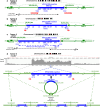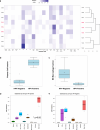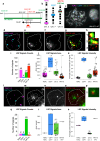Structure and transcription of integrated HPV DNA in vulvar carcinomas
- PMID: 38898085
- PMCID: PMC11187145
- DOI: 10.1038/s41525-024-00418-8
Structure and transcription of integrated HPV DNA in vulvar carcinomas
Abstract
HPV infections are associated with a fraction of vulvar cancers. Through hybridization capture and DNA sequencing, HPV DNA was detected in five of thirteen vulvar cancers. HPV16 DNA was integrated into human DNA in three of the five. The insertions were in introns of human NCKAP1, C5orf67, and LRP1B. Integrations in NCKAP1 and C5orf67 were flanked by short direct repeats in the human DNA, consistent with HPV DNA insertions at sites of abortive, staggered, endonucleolytic incisions. The insertion in C5orf67 was present as a 36 kbp, human-HPV-hetero-catemeric DNA as either an extrachromosomal circle or a tandem repeat within the human genome. The human circularization/repeat junction was defined at single nucleotide resolution. The integrated viral DNA segments all retained an intact upstream regulatory region and the adjacent viral E6 and E7 oncogenes. RNA sequencing revealed that the only HPV genes consistently transcribed from the integrated viral DNAs were E7 and E6*I. The other two HPV DNA+ tumors had coinfections, but no evidence for integration. HPV-positive and HPV-negative vulvar cancers exhibited contrasting human, global gene expression patterns partially overlapping with previously observed differences between HPV-positive and HPV-negative cervical and oropharyngeal cancers. A substantial fraction of the differentially expressed genes involved immune system function. Thus, transcription and HPV DNA integration in vulvar cancers resemble those in other HPV-positive cancers. This study emphasizes the power of hybridization capture coupled with DNA and RNA sequencing to identify a broad spectrum of HPV types, determine human genome integration status of viral DNAs, and elucidate their structures.
© 2024. The Author(s).
Conflict of interest statement
M.H.E. has advised or participated in educational speaking activities but does not receive an honorarium from any companies. In specific cases, his employer has received payment for his time spent on these activities from Asieris, Papivax, Merck, BD, and PDS Biotechnologies. If travel is required for meetings with the industry, the company pays for M.H.E.’s travel expenses. Rutgers has received grant funding for research-related costs of clinical trials that he has been the overall or local PI within the past 12 months from J&J, Pfizer, Inovio, AstraZeneca, Imvax, Iovance, PDS Biotechnologies, and Becton-Dickinson. M.H.E. is a consultant to the World Health Organization. Payment for these efforts goes to Rutgers. M.H.E. has leadership positions in ASCCP, SGO. The other authors declare no potential conflicts of interest.
Figures








Similar articles
-
Physical status and expression of HPV genes in cervical cancers.Gynecol Oncol. 1997 Apr;65(1):121-9. doi: 10.1006/gyno.1996.4596. Gynecol Oncol. 1997. PMID: 9103401
-
Inactivation of the human papillomavirus E6 or E7 gene in cervical carcinoma cells by using a bacterial CRISPR/Cas RNA-guided endonuclease.J Virol. 2014 Oct;88(20):11965-72. doi: 10.1128/JVI.01879-14. Epub 2014 Aug 6. J Virol. 2014. PMID: 25100830 Free PMC article.
-
Integration and viral oncogene expression of human papillomavirus type 16 in oropharyngeal squamous cell carcinoma and gastric cancer.J Med Virol. 2023 May;95(5):e28761. doi: 10.1002/jmv.28761. J Med Virol. 2023. PMID: 37212316
-
HPV DNA, E6/E7 mRNA, and p16INK4a detection in head and neck cancers: a systematic review and meta-analysis.Lancet Oncol. 2014 Nov;15(12):1319-31. doi: 10.1016/S1470-2045(14)70471-1. Epub 2014 Oct 16. Lancet Oncol. 2014. PMID: 25439690
-
HPV Integration in Head and Neck Squamous Cell Carcinomas: Cause and Consequence.Recent Results Cancer Res. 2017;206:57-72. doi: 10.1007/978-3-319-43580-0_4. Recent Results Cancer Res. 2017. PMID: 27699529 Review.
Cited by
-
Precision medicine in gynecological cancer (Review).Biomed Rep. 2025 Jan 8;22(3):43. doi: 10.3892/br.2025.1921. eCollection 2025 Mar. Biomed Rep. 2025. PMID: 39810899 Free PMC article. Review.
-
Informatics at the Frontier of Cancer Research.Cancer Res. 2025 Aug 15;85(16):2967-2986. doi: 10.1158/0008-5472.CAN-24-2829. Cancer Res. 2025. PMID: 40600473 Free PMC article. Review.
-
Serum, Cell-Free, HPV-Human DNA Junction Detection and HPV Typing for Predicting and Monitoring Cervical Cancer Recurrence.medRxiv [Preprint]. 2025 Jan 6:2024.09.16.24313343. doi: 10.1101/2024.09.16.24313343. medRxiv. 2025. PMID: 39830266 Free PMC article. Preprint.
References
-
- Surveillance, Epidemiology, and End Results (SEER) Program (www.seer.cancer.gov) SEER*Stat Database: Incidence - SEER Research Data, 8 Registries, Nov 2023 Sub (1975-2021) - Linked To County Attributes - Time Dependent (1990-2022) Income/Rurality, 1969-2022 Counties, National Cancer Institute, DCCPS, Surveillance Research Program, released April 2024, based on the November 2023 submission.
Grants and funding
- R21 CA240580/CA/NCI NIH HHS/United States
- P30 CA072720/CA/NCI NIH HHS/United States
- CA240580/U.S. Department of Health & Human Services | NIH | National Cancer Institute (NCI)
- P30CA072720/U.S. Department of Health & Human Services | NIH | National Cancer Institute (NCI)
- P30CA013330P30CA013330/U.S. Department of Health & Human Services | NIH | National Cancer Institute (NCI)
LinkOut - more resources
Full Text Sources

